Timeline
A strong year in science fiction magazines sees 110 separate issues of 25 titles, 15 of which are introduced this year alone.
Grosset & Dunlap becomes one of the first general publishers to introduce a series of science fiction novels, which had largely been confined to specialty and amateur presses previously. Despite featuring such authors as Henry Kuttner, Jack Williamson, and A. E. van Vogt, the series does not last long.
January 2
In its column “Topics of the Times,” the New York Times covers a meeting of New York’s Hydra Club of science fiction writers and editors, noting that “Science fiction has made incredible progress in the past two decades, graduating from the pulp magazine era to its modern respectability of hard-cover books and publishers’ advertising appropriations rivaling those of detective stories. . . . Yet to our mind the remarkable thing is that we aren’t all science fiction addicts, rather than that so many of us are. We are literally living in a world whose technological civilization would have been considered fantastic even in 1900.”
January 19
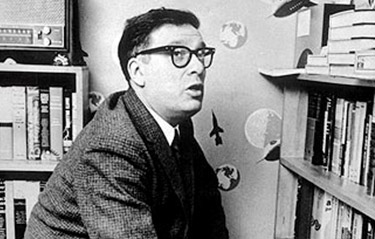
Isaac Asimov’s first novel, Pebble in the Sky, is published.
January 21
George Orwell, whose 1984 established a new standard in dystopian fiction only two years earlier, dies.
January 31
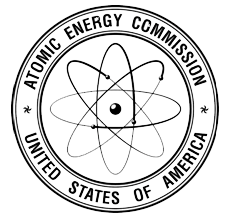
President Truman orders the Atomic Energy Commission to begin development of the hydrogen bomb, partly in response to the Soviet Union’s first explosion of an atomic bomb five months earlier.
February 2
In London, atomic scientist Klaus Fuchs is arrested for supplying nuclear secrets to the Soviet Union. He is later sentenced to 14 years in prison.
February 9
Senator Joseph McCarthy of Wisconsin, speaking to a Republican women’s club in West Virginia, announces (with no evidence) that he has a list of “205 . . . members of the Communist Party . . . still working and shaping policy in the State Department.”
February 11
“Report on the Barnhouse Effect,” the first story published by Kurt Vonnegut, Jr., appears in Collier’s magazine. Collier’s will become a familiar general-magazine outlet for writers such as Vonnegut, Jack Finney, and Ray Bradbury, and an enthusiastic proponent of space exploration.
March 9
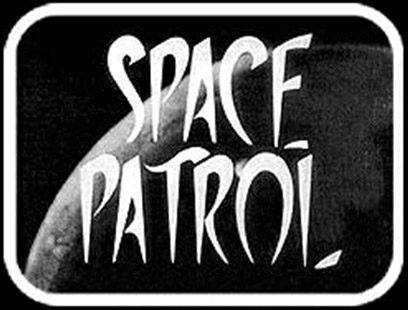
Space Patrol, a TV series featuring Commander Buzz Corry, debuts on a local TV station in Los Angeles, and eventually becomes a network series that will survive until 1955.
March 15
The Mutual Radio network debuts 2000 Plus, the earliest effort at an adult-oriented science fiction anthology radio drama, which will run until January 1952.
March 29
RCA announces the development of a color TV tube. A survey finds that children aged 11–15 are already devoting nearly 27 hours a week to TV watching.
April 3
Immanuel Velikovsky’s pseudoscientific Worlds in Collision is published, arguing that catastrophic events from world mythologies can be explained by Venus having been ejected from Jupiter in the 15th century B.C. and passing near earth. Though it spends most of the year on bestseller lists, its premise is so uniformly rejected by the scientific community that its original publisher, Macmillan, abandons it.
April 8
Dimension X, a radio anthology series largely adapted from stories in Astounding and other magazines, debuts on NBC, dramatizing classic stories by Heinlein, Asimov, Bradbury, and others. It will survive until September 1951.
May
Science fiction pulp writer L. Ron Hubbard's "Dianetics, the Evolution of a Science" is published in Astounding Science Fiction, preceding the publication of Hubbard’s popular book which will eventually lead to the Scientology movement.
May 6
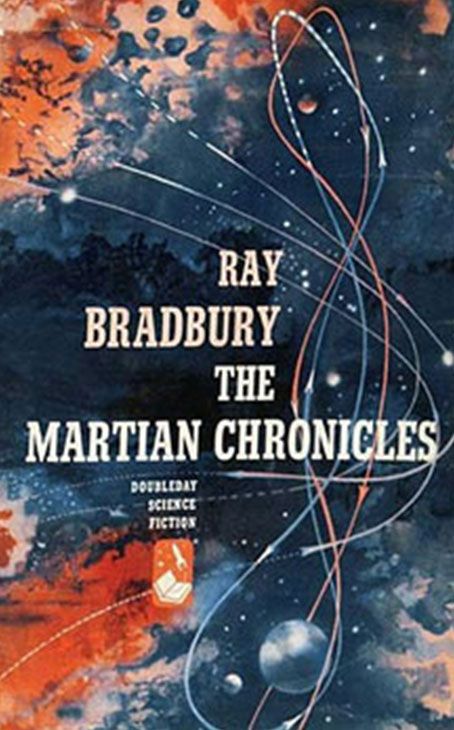
Ray Bradbury’s The Martian Chronicles is published by Doubleday.
May 12
August Derleth’s historical anthology Beyond Time and Space seeks to establish historical roots for science fiction by including selections from Plato, Lucian, Rabelais, More, Bacon, Swift, Kepler, Poe, and others.
May 21
New York Times film critic Helen Gould describes a new Hollywood trend toward science fiction films, mentioning the forthcoming Destination Moon and plans for future films When Worlds Collide and The Day the Earth Stood Still, and notes “there is already a new term in the trade lingo for the new cycle—‘S.F.,’ a typical movietown abbreviation for science fiction.”
Summer 1950
Richard Matheson's first published story, "Born of Man and Woman" appears in The Magazine of Fantasy and Science Fiction
June 15
Judith Merril, later an influential editor, publishes Shadow on the Hearth, one of the first science fiction novels to consider nuclear war from the perspective of a suburban family.
June 25
The Korean War begins as North Korea invades South Korea.
June 27
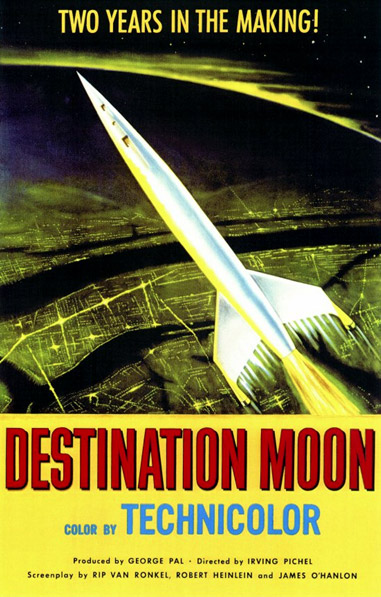
George Pal’s film Destination Moon, directed by Irving Pichel and with Robert A. Heinlein as a script consultant, opens in New York. It is the first American film to attempt to depict space travel in technologically realistic terms.
July 15
Winston Churchill, in a speech in London, warns about a Third World War, which has already become a dominant theme in popular science fiction.
August 12
The Department of Defense and the Atomic Energy Commission publish a 438-page guide on civil defense, describing the potential effects of nuclear weapons on U.S. cities.
September 1
Theodore Sturgeon publishes The Dreaming Jewels, his first novel.
September 1–4
The 8th World Science Fiction Convention, called Norwescon, is held in Portland, Oregon, with Anthony Boucher as guest of honor. It attracts about 400 attendees, more than twice the size of previous “Worldcons.”
September 8
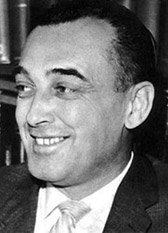
A. E. van Vogt publishes The Voyage of the Space Beagle, a “fix-up” novel from previously published stories, one of which would much later provide the inspiration for the film Alien.
September 9
Norbert Wiener, who had earlier coined the term “cybernetics” in his 1948 book of that title, publishes The Human Use of Human Beings: Cybernetics and Society, arguing the benefits of automation but warning of possible misuse and wide unemployment.
September 19
Everett F. Bleiler and T. E. Dikty’s The Best Science Fiction Stories: 1950 is published by Frederick Fell as the second of their annual anthologies of magazine science fiction. The series is the first of many “year’s best” anthology series.
September 24
In an article in The New York Times, critic Villiers Gerson claims, “The future of science fiction seems assured,” while noting that “more science fiction anthologies and novels will be published this fall alone than in any previous full year.”
October
The inaugural issue of Galaxy Science Fiction is published under the editorship of H. L. Gold, including stories by Isaac Asimov, Fritz Leiber, and Theodore Sturgeon. Together with The Magazine of Fantasy and Science Fiction, introduced the previous fall, it will provide an alternative to John W. Campbell’s long-dominant Astounding Science Fiction in developing markets for literary or satirical science fiction.
October 2
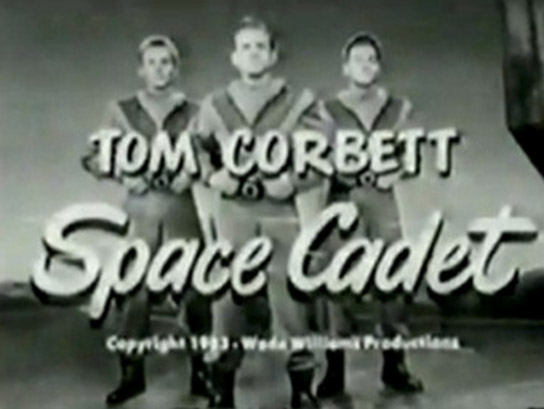
Tom Corbett, Space Cadet, loosely inspired by Robert A. Heinlein’s 1948 novel Space Cadet, debuts on CBS television, and will continue on various networks until 1955.
October 4
The Lonely Crowd by David Riesman, Reuel Denney, and Nathan Glazer describes the increase in “outer-directed” behavior and conformity among Americans.
October 31
Robert A. Heinlein’s story collection The Man Who Sold the Moon is published, outlining his ongoing “Future History” series of stories and novels.
November
Robert A. Heinlein publishes the juvenile novel Farmer in the Sky with Charles Scribner’s Sons.
December 2
Isaac Asimov publishes I, Robot, a collection of his popular robot stories, with Gnome Press, a small independent publisher devoted to science fiction.
January 12
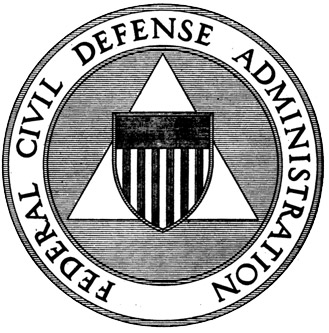
The Federal Civil Defense Administration is established and given the task of educating the U.S. public on methods of protection against nuclear attack.
February
Ray Bradbury publishes “The Fireman” in Galaxy Science Fiction, which will be expanded into the novel Fahrenheit 451 in 1953.
February 15
The Stars Like Dust, Isaac Asimov’s second science fiction novel, is published.
February 17
In an address to the Yale Club, Harvard president James B. Conant complains that science educators have “apparently been unable to put across to students, who have not majored in the sciences, just what science is all about. The public acceptance of science fiction or fiction disguised as science is our indictment.”
March 29
A jury finds Ethel and Julius Rosenberg guilty of transmitting nuclear secrets to the Soviet Union. They are sentenced to death by federal judge Irving Kaufman on April 5.
April 29
The Thing from Another World, based on a story by John W. Campbell, Jr. and directed by Christian Nyby (with uncredited direction by Howard Hawks), opens in the U.S., helping to initiate a cycle of popular science fiction monster movies. It will later be remade in 1982 and in 2011.
May 8
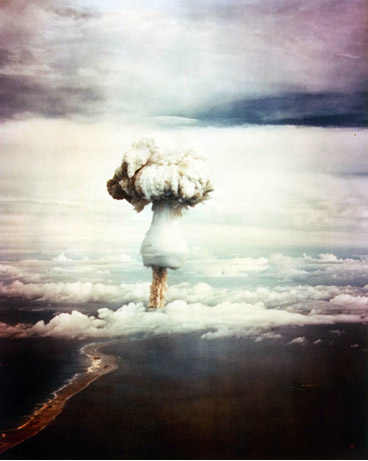
A team of American scientists on Eniwetok Atoll in the Pacific Ocean use an atomic bomb explosion to test the principles of thermonuclear fusion.
June 5
A.E. van Vogt’s The Weapon Shops of Isher is published in book form by Greenberg.
June 14
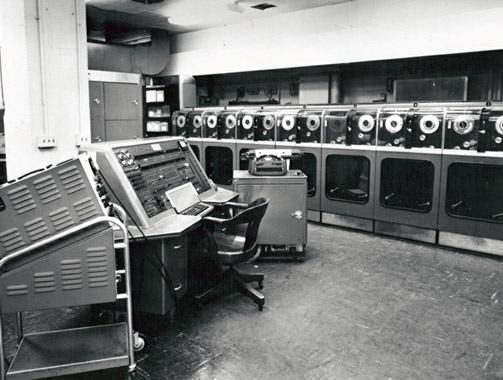
The U.S. Census Bureau places in service the first commercial business and scientific computer, called UNIVAC (for Universal Automatic Computer), based on the 1946 ENIAC computer.
June 23
The Saturday Evening Post publishes Ray Bradbury’s “The Fog Horn,” which will provide the basis for the 1953 monster film The Beast from 20,000 Fathoms.
August 3
Tales of Tomorrow, the first science fiction anthology TV series and reportedly the brainchild of Theodore Sturgeon, debuts on the ABC network with Sturgeon’s “Verdict from Space,” and will adapt classic tales by H. G. Wells, Jules Verne, Mary Shelley, C. M. Kornbluth, and others. It will continue until 1953.
September
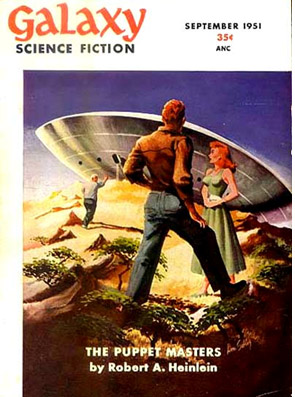
Robert A. Heinlein begins serializing The Puppet Masters in Galaxy Science Fiction.
September 1–3
The ninth World Science Fiction Convention is held in New Orleans, with an attendance of 190. Fritz Leiber is guest of honor.
September 4
The first transcontinental television programming is broadcast via coaxial cable.
September 28
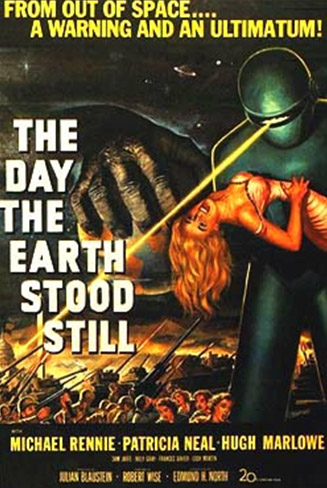
Robert Wise’s film The Day the Earth Stood Still, based on an Astounding Science Fiction story by Harry Bates, is released, and is received as one of the first mature efforts to represent science fiction in film.
October 10
Bell Telephone introduces the first commercial application of the transistor in trunk dialing and long distance direct dial service.
October 27
Air Force Captain Edward Ruppelt is given command of Project Grudge, the Air Force’s ongoing investigation of myriad UFO reports dating back to 1947, and attempts to systematize the reporting. Eventually reconstituted as Project Blue Book, the investigations will continue until 1969.
November
Isaac Asimov’s Foundation is published by Gnome Press, collecting the first nine stories of what will become know as “the Foundation trilogy.”
January–March
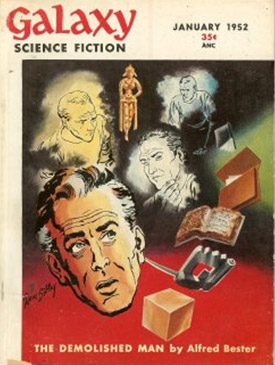
Alfred Bester serializes The Demolished Man in Galaxy magazine. The book will be published the following year.
January 26
The John C. Winston publishing company announces the first five titles in its new series of juvenile science fiction novels which, later under the imprint Holt, Rinehart, and Winston, will extend to 35 novels before ending in 1961, including titles by Poul Anderson, Arthur C. Clarke, Lester del Rey, Donald A. Wollheim, and others.
February 23
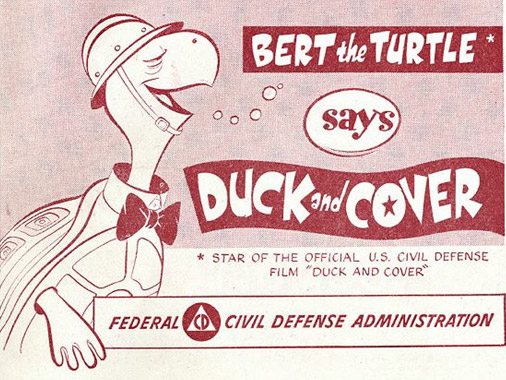
“Duck and Cover,” a short educational film produced by federal civil defense authorities to provide guidance on protection against nuclear attack, is first shown on television in the New York market, and later will be widely distributed on television and in classrooms. It will later be widely parodied and criticized for its naivete regarding atomic explosions.
February 25
H. L. Gold publishes The Galaxy Reader of Science Fiction, highlighting that magazine’s growing prominence in satirical and social science fiction.
March 3
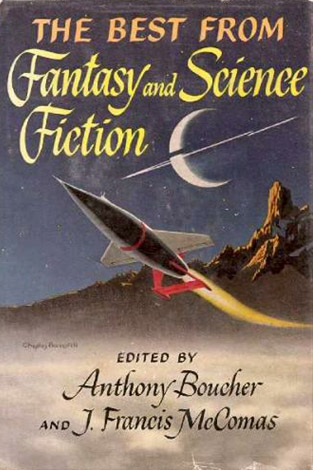
The Best from Fantasy and Science Fiction, edited by Anthony Boucher and J. Francis McComas, with stories drawn from what has begun to be regarded as the most literary of the science fiction magazines is published.
March 20
John W. Campbell, Jr. publishes The Astounding Science Fiction Anthology, the third such magazine anthology within a month, helping to cement that magazine’s reputation as the leading science fiction magazine of the 1940s.
March 22
Under the title “Man will Conquer Space Soon,” Collier’s Magazine publishes the first of what will be seven issues over the next two years detailing the future of manned space exploration, with articles by Wernher von Braun, Willy Ley, Cornelius Ryan, and others.
May
Ian and Betty Ballantine launch a new paperback imprint to be called Ballantine Books, which will announce its first titles in September and the following year institute an influential program of science fiction publishing beginning with Frederik Pohl and C. M. Kornbluth’s The Space Merchants.
May 2
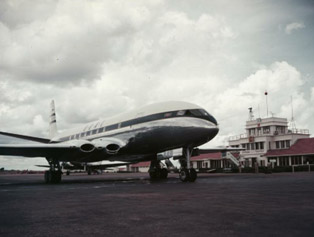
The first commercial passenger jet flies between London and Johannesberg.
May 17
New York Times science editor Waldemar Kaempffert argues that, while science fiction writers have addressed such topics as “electronic thinking machines based on Norbert Wiener’s ‘Cybernetics,’” the genre “will consist largely of thrillers” and in literary terms, “Few science fiction stories can stand the test.”
May 25
It Came from Outer Space, directed by Jack Arnold from an initial screen treatment by Ray Bradbury, opens, presaging the monster B-movie renaissance of the 1950s.
June–August
Frederik Pohl and C. M. Kornbluth serialize Gravy Planet in Galaxy Science Fiction magazine, which is the first appearance of the novel retitled as The Space Merchants.
June 28
Ray Bradbury’s “A Sound of Thunder” is published in Collier’s, and over the next four decades will become probably the most frequently reprinted American science fiction story.
July
Philip K. Dick’s first published story, “Beyond Lies the Wub,” appears in Planet Stories.
July 14
The Toy Guidance Council, an industry watchdog group, announces a “trend toward toys dealing with space travel and atomic energy” among toys being prepared for the Christmas season. “Television has always influenced the demand for toys, and now, with many science fiction programs on the air, the western types are waning slightly.”
July 19–26
The Washington, D.C. area experiences a series of alleged UFO sightings, including radar signals, which revive interest in the “flying saucers” that have become prominent in popular culture since a famous sighting in 1947.
August

Kurt Vonnegut, Jr.’s first novel, the dystopian Player Piano, is published by Scribner’s.
August
Philip José Farmer’s “The Lovers” appears in Startling Stories, initiating a widespread discussion of sexuality in science fiction.
August
Andre Norton’s young adult novel Star Man’s Son, although her seventh novel, inaugurates a long career as a popular science fiction and fantasy author.
August 30–Sept. 1
The tenth annual World Science Fiction convention is held in Chicago with an attendance of about 870—more than double that of the previous largest Worldcon in 1950. Hugo Gernsback is guest of honor, and the convention votes to institute annual science fiction awards called the Hugo, to be initially presented the following year.
September
The first “Ace Double” paperbacks—short novels bound back-to-back—are published by Ace Publishing Company under the direction of A. A. Wyn, and Donald Wollheim, who had left Avon earlier in the year to help develop a new paperback line. Although the first science fiction titles will not be released until next year, the line becomes a familiar staple of science fiction publishing, featuring titles by A. E. van Vogt, Philip K. Dick, Robert E. Howard, Isaac Asimov, Robert Silverberg, Harlan Ellison, and others.
September
Clifford D. Simak’s City collects his popular stories of a posthuman Earth into a “fix-up” novel, which would win the following year’s International Fantasy Award.
September 19
Superman, based on the long-running comic book created by Jerry Siegel and Joe Shuster, debuts as a syndicated television show, and will continue until April 1958.
October
Wilson Tucker’s The Long Loud Silence presents such a grim view of life after a nuclear war that its original ending was rejected by the publisher.
November
Bernard Wolfe’s first novel, the ambitious dystopian science fiction novel Limbo, is published.
November
Ward Moore’s novella “Bring the Jubilee” is published in The Magazine of Fantasy and Science Fiction. Expanded into a novel the following year, its treatment of a U.S. in which the South won the Civil War is regarded as a pioneering work in the alternate history subgenre.
November 1
The first test of a hydrogen (thermonuclear) bomb is carried out by the United States on Eniwetok Atoll, validating a design developed by physicist Edward Teller and mathematician Stanislaw Ulam. The 10 megaton explosion completely destroys the small coral island of Elugelab.
November 4
Dwight Eisenhower defeats Adlai Stevenson in the presidential election, the first election to be accurately predicted by a computer (UNIVAC).
December
Dynamic Science Fiction launches its first issue. Although it lasts only six issues, it is effectively the last pulp science magazine featuring original fiction to debut in the United States.
December 5–8
A four-day London smog—heavy fog combined with sulfur dioxide, nitrogen oxides, and soot—results in more than 4,700 deaths, dramatically raising awareness of atmospheric pollution.
December 20
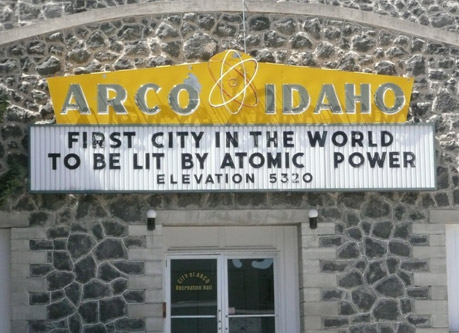
The U.S. Government turns on Experimental Breeder Reactor #1 near Arco, Idaho, inaugurating the first peacetime use of nuclear power to generate electricity.
By year’s end, 17 million U.S. homes have TV sets, and more that 275 million paperback books have been printed—up from 66 million in 1945. Both are ominous signs for the magazine and pulp magazine industries.
January 1
The ABC radio series Tales of Tomorrow, intended as a companion to the network’s TV series of the same name, debuts, drawing most of its stories from Galaxy magazine. It continues only until April 9.
February 20
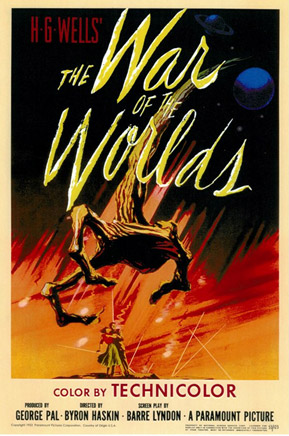
George Pal’s movie adaptation of H. G. Wells’s The War of the Worlds premieres in Hollywood (though not in general release until autumn), becoming the most successful science fiction film of the year.
March
Doubleday launches the Science Fiction Book Club; its first selection is Isaac Asimov’s The Currents of Space.
April
In Astounding Science Fiction, Hal Clement begins serializing Mission of Gravity, which, published as a novel in 1954, will help to define the scientifically rigorous style of imagination known as “hard science fiction.”
April 11
Speaking at Case Institute of Technology’s Diamond Jubilee, Claude Shannon of Bell Labs notes that, with the introduction of transistors and “ferro-electric” memory, “the computers of the future may be extremely compact.” He goes on to cite mathematician John von Neumann’s idea of self-replicating machines. “Writers of science fiction will no doubt take note,” reports the New York Times.
April 25
Nature magazine publishes a one-page article by James Watson and Francis Crick suggesting a structure for DNA, which “has novel features that are of considerable biological interest.” Watson and Crick had announced the discovery at a conference on April 8, but it was not widely reported.
May 25
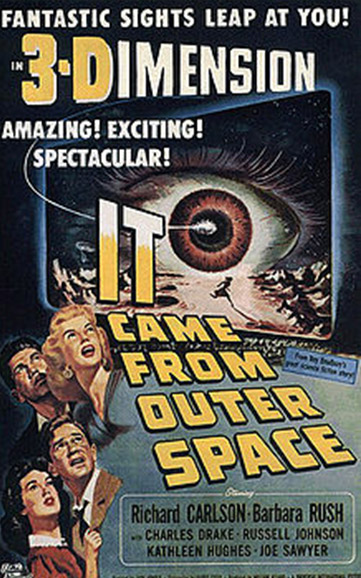
Jack Arnold’s film It Came from Outer Space, based on a screen treatment by Ray Bradbury, is the first 3-D film released by Universal.
June 13
The Beast from 20,000 Fathoms is released, the second film this year based on a Ray Bradbury treatment, in this case drawn from his short story “The Fog Horn.”
June 19
Julius and Ethel Rosenberg are executed for providing atomic secrets to the Soviet Union.
July 27
The Korean War ends as an armistice is signed by North Korea, China, and the United Nations Command in Korea.
August 12
The Soviet Union detonates its first hydrogen bomb.
September
“A Case of Conscience” by James Blish appears in If magazine, and will later form the first section of his 1958 novel of the same title.
September
Wilmar Shiras’s Children of the Atom, expanded slightly from three stories she had published beginning in 1948, is released to wide praise as one of the genre’s early mature treatments of psychological and developmental themes.
September
Modern Science Fiction: Its Meaning and Its Future, a “symposium” edited by Reginald Bretnor and featuring essays by John W. Campbell, Isaac Asimov, Philip Wylie, and others is the first critical book on science fiction from a major publishing house.
September 5–7
The 11th World Science Fiction convention opens in Philadelphia, and is the first to present the Science Fiction Achievement Awards, informally known as Hugos. Alfred Bester’s The Demolished Man wins best novel, and a Hugo for Best New Writer goes to Philip José Farmer.
October
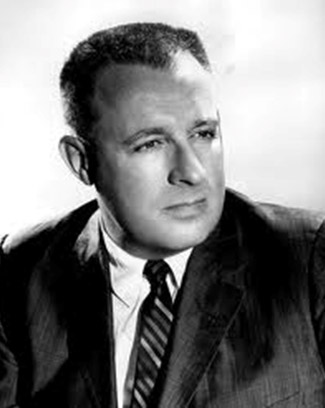
Ray Bradbury publishes Fahrenheit 451 with Ballantine Books.
October–December
Isaac Asimov serializes The Caves of Steel, the first of his popular robot detective novels, in Galaxy magazine.
October
The first “Ace Double” paperback to feature science fiction includes A. E. van Vogt’s The World of Null-A and The Universe Maker. Issued on a bimonthly and later a monthly schedule, the Ace Doubles begin to develop a loyal audience comparable to that of the magazines.
November
Theodore Sturgeon’s More Than Human is published in simultaneous hardcover (Farrar Straus & Young) and paperback (Ballantine) formats.
November
Marion Zimmer Bradley’s first two stories are published in the short-lived magazine Vortex.
December
In Chicago, Hugh Hefner publishes the first issue of Playboy magazine, which despite its primary reputation will later provide a significant general-magazine outlet for a number of science fiction writers, including Ray Bradbury, whose Fahrenheit 451 is serialized in early 1954.
December
Former pulp science fiction writer L. Ron Hubbard incorporates the first Church of Scientology in Camden, New Jersey.
January
Philip Wylie’s Tomorrow!, a graphic depiction of nuclear war and an impassioned civil defense tract, is published and goes on to spend 17 weeks on the New York Times bestseller lists, making it the most popular nuclear-war novel to date.
January 21
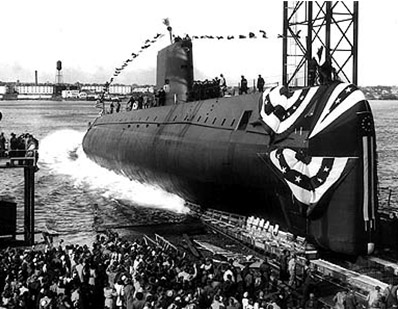
The first nuclear submarine, the Nautilus, is launched by the U.S. Navy at Groton, Connecticut.
February–April
Playboy magazine serializes Ray Bradbury’s Fahrenheit 451, bringing science fiction to attention of a broad, young (and almost entirely male) readership.
March 1
The United States tests a 15 megaton hydrogen bomb on Bikini Atoll in the Pacific, creating radioactive fallout that kills a crewman on a Japanese fishing boat. The incident helps inspire Ishiro Honda's monster film Gojira.
March 5
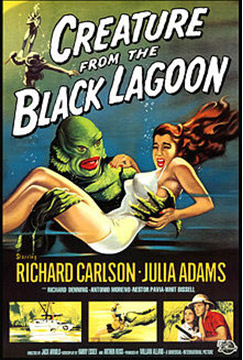
The Creature from the Black Lagoon, directed by Jack Arnold, firmly establishes this director’s reputation for popular low-budget science fiction monster movies.
April
Psychiatrist Fredric Wertham, whose book The Seduction of the Innocent earlier this year had posited a link between violent comic books and juvenile crime, testifies before Estes Kefauver’s Senate Subcommittee on Juvenile Delinquency. The resulting furor eventually leads a number of comics to cease publication, and, because of shared distribution channels, impacts the pulp magazine market as well.
May 17
In Brown vs. the Board of Education, the U.S. Supreme Court declares racial segregation in public education to be unconstitutional.
June 19
The Gordon Douglas film Them! premieres, helping to introduce a wave of 1950s monster movies (in this case, giant ants).
July
Born of Man and Woman, Richard Matheson’s first short story collection, is published, as is his first novel, I Am Legend, a vaguely science fictional take on the vampire legend, which will later be filmed three times, in 1964, 1971, and 2007.
July
“My Boyfriend’s Name Is Jello,” the first story by distinguished fantasist Avram Davidson, is published in The Magazine of Fantasy and Science Fiction.
September
Weird Tales, the most venerable of the fantastic fiction pulps, ceases publication after 31 years. Although it will be revived occasionally in coming decades, its pulp magazine incarnation is at an end.
September 3-6
The 12th annual World Science Fiction Convention is held in San Francisco, drawing an attendance of about 700. Guest of honor is John W. Campbell, Jr.
September 17
William Golding’s The Lord of the Flies is published in England.
November 26
Collier’s magazine begins serializing Jack Finney’s novel The Body Snatchers, which will eventually be filmed four times over the next five decades, usually as Invasion of the Body Snatchers.
March 9
The television program Disneyland airs a popular episode entitled “Man in Space,” discussing the history of rocketry and potential problems posed by spaceflight. The episode, narrated in part by Wernher von Braun and Willy Ley, will later be re-edited as a theatrical short and provide the basis for both a comic book, a classroom text, and a popular ride at Disneyland. It will be followed by other episodes “Man in the Moon” (December 28, 1955) and “Mars and Beyond” (December 4, 1957).
April 12
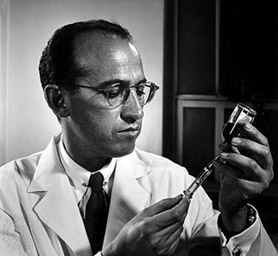
Following wave of serious and widely fatal polio outbreaks, the successful large-scale trials of Jonas Salk’s polio vaccine are publicly announced.
April 24
NBC radio series X Minus One debuts with mostly original scripts, but will begin adapting stories exclusively from Galaxy magazine in February 1956, and will eventually run to 125 episodes, ending in January 1958.
May 8
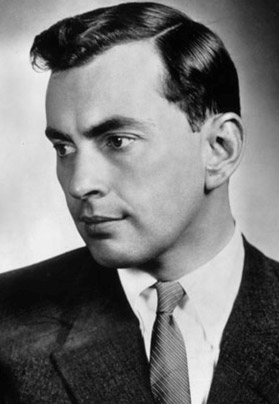
Gore Vidal’s play Visit to a Small Planet, satirizing the Cold War, McCarthyism, and American obsession with television from the point of view of a visiting alien, debuts on the Goodyear Television Playhouse. Later reworked as a Broadway play, it will debut on February 7, 1957, will run for 388 performances, and will provide the basis for a 1960 Jerry Lewis film.
July 18
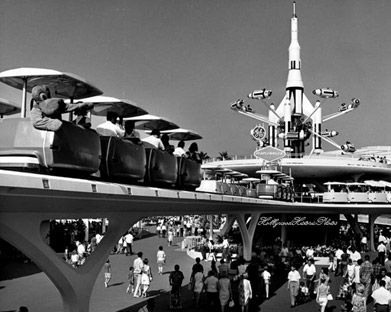
Disneyland theme park opens in Anaheim, California. One of its principal themed areas, “Tomorrowland,” features corporate-sponsored exhibits such as the TWA Moonliner, a simulated voyage to the moon, and the Monsanto House of the Future. Another exhibit, “Autopia,” offers a preview of the planned Interstate Highway system.
August
A Japanese tape-recorder company introduces the first pocket-sized transistor radios in the U.S. under the brand name Sony, with limited success.
September 2–5
The 13th annual World Science Fiction Convention in Cleveland, with Isaac Asimov as guest of honor, draws about 380 attendees.
September
Leigh Brackett’s The Long Tomorrow is published by Doubleday, without a prior magazine serialization.
October
Startling Stories, the last of the classic pulp magazines (it began in 1939), ceases publication with its fall issue, leaving only one traditional science fiction pulp magazine, Science Fiction Quarterly.
November
The second issue of the new magazine Infinity includes “Glow-worm,” the first professional story sale by Harlan Ellison.
By the end of 1955, only eleven professional science fiction magazines remain on the market, compared to 25 in 1950.
February 5
Don Siegel’s Invasion of the Body Snatchers, based on Jack Finney’s novel The Body Snatchers originally serialized in Collier’s in 1954, is released and is widely regarded as a political or social allegory. It will be remade in 1978, 1993, and 2007.
February 22
Elvis Presley’s “Heartbreak Hotel” becomes his first No. 1 single.
February–April
Robert A. Heinlein’s Double Star is serialized in Astounding Science Fiction and published as a book in March.
April 1
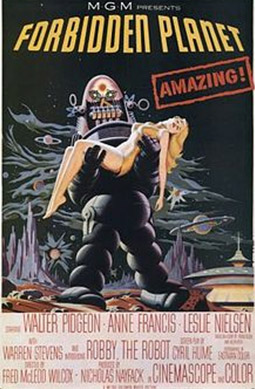
Forbidden Planet, directed by Fred Wilcox, is released, becoming one of the most popular of all science fiction films, with its elaborate special effects, unusually sophisticated plot, and pioneering use of electronic music.
April 27
Godzilla, King of the Monsters is released. Considerably re-edited from Ishiro Honda’s 1954 Japanese original Gojira, and with new material added, it begins a new spate of giant-monster films.
May
Richard Matheson’s The Shrinking Man is published.
June 29
President Dwight Eisenhower signs into law the National Interstate and Defense Highways Act, paving the way for the development of the Interstate Highway System.
August 31–September 3
The 14th annual World Science Fiction Convention, the first in New York since 1939, draws an attendance of about 850. Robert A. Heinlein wins the best novel Hugo for Double Star, and Robert Silverberg is “most promising new author.”
September 4
Following the World Science Fiction Convention in New York, the first Milford Science Fiction Writers Conference convenes in Milford, Pennsylvania. Organized by Damon Knight, James Blish, and Judith Merril, it attracts many of the leading writers in the field and will become the forerunner of many later professional science fiction workshops, including the long-running Clarion program.
October–December
Isaac Asimov’s The Naked Sun, another of his popular robot detective novels, is serialized in Astounding Science Fiction.
October–January
Alfred Bester’s The Stars My Destination is serialized in Galaxy Science Fiction.
October 25
Soviet Army troops invade Hungary in response to a revolt that began two days earlier.
October 29
Israel invades the Sinai Peninsula, beginning the Suez Crisis.
November
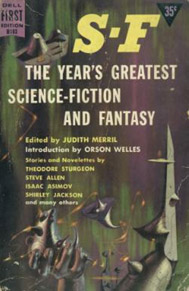
Judith Merril’s SF: The Year’s Greatest Science Fiction and Fantasy, with stories by authors as diverse as Algis Budrys, Isaac Asimov, Shirley Jackson, and Zenna Henderson, inaugurates an influential and long-running series which will seek to expand the literary compass of science fiction.
January 4
The final issue of Collier’s magazine, which earlier in the decade had prominently featured science fiction writers such as Ray Bradbury and Jack Finney and promoted space travel in a series of nonfiction articles, is published, removing from the market one of the few general-interest magazines to feature science fiction.
March
Cele Goldsmith, hired as a secretary two years earlier, becomes managing editor of Ziff-Davis magazines Amazing and Fantastic, becoming editor the following December. She eventually discovers or promotes the early work of Ursula K. Le Guin, Thomas M. Disch, Roger Zelazny, and J. G. Ballard.
March 12
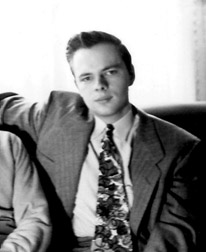
Philip K. Dick’s novel Eye in the Sky is published by Ace.
March 19
James Blish’s The Frozen Year, one of the few science fiction novels to specifically address the International Geophysical Year, is published by Ballantine.
April 12
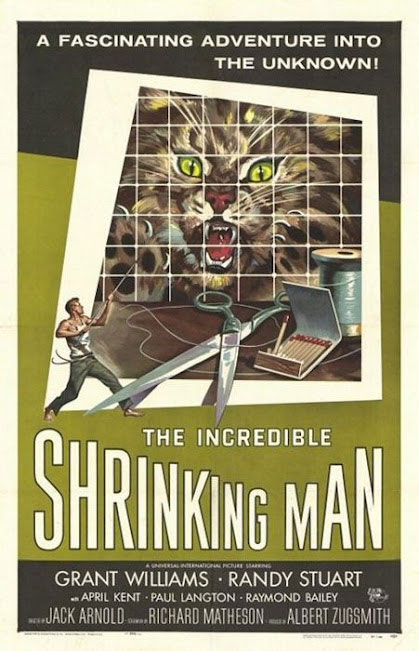
The Incredible Shrinking Man, directed by Jack Arnold with a screenplay by Richard Matheson from his novel, is released.
June
The leading U.S. distributor of magazines and books, American News Company, goes into liquidation and ceases distributing magazines, resulting in a wide collapse of the science fiction magazine market. Of the 20 titles available this year, only six will survive through 1960.
July 1
Under the auspices of the International Council of Scientific Unions, an “International Geophysical Year” is inaugurated, which will last through the end of 1958 and see the launching of the first artificial earth satellites, the discovery of the Van Allen radiation belts, improved charting of ocean currents, and discoveries that help validate the theory of plate tectonics.
July 24
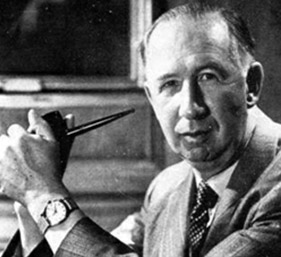
British-Australian author Nevil Shute’s nuclear war novel On the Beach is published in the U.S. and remains on the New York Times bestseller list for 29 weeks, failing to reach #1 only because of the phenomenal success of Grace Metalious’s Peyton Place. It later provides the basis for Stanley Kramer’s 1959 film.
July 29
The International Atomic Energy Agency is established to promote peaceful uses of nuclear energy.
September 6–9
The 15th annual World Science Fiction convention in London is the first held outside North America and draws an attendance of 268. John W. Campbell, Jr., the editor of Astounding Science Fiction, becomes the first three-time guest of honor (he had previously been guest of honor in 1947 and 1954).
September–December
Robert A. Heinlein’s Citizen of the Galaxy is serialized in Astounding Science Fiction and published in hardcover by Scribner’s.
October 4
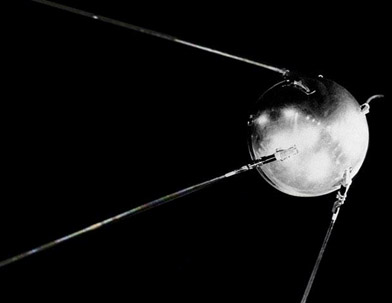
The Soviet Union makes a surprise announcement of the launching of the first artificial earth satellite, Sputnik, which is widely regarded as the inauguration of the space race.
October 10
Ayn Rand’s massive dystopian novel Atlas Shrugged is published, quickly becoming a bestseller and promoting a philosophy of “rational self-interest” that will sustain a cult-like following for the next half-century.
November 3
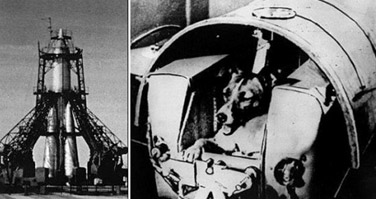
The Soviet Union launches Sputnik 2, carrying the dog Laika as the first animal into space.
November 7
The “Gaither Report” of President Eisenhower’s Science Advisory Committee recommends strengthening U.S. nuclear deterrent capabilities and relegating fallout shelters and other civilian defense measures to a secondary priority.
December 4
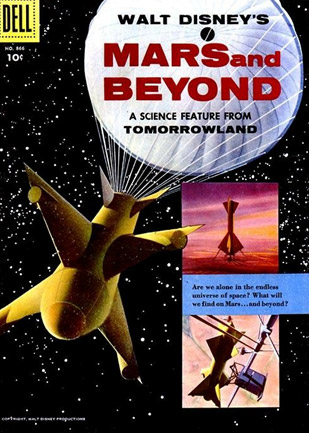
“Mars and Beyond,” the third of the television program Disneyland’s programs devoted to space exploration, includes animated treatments of Mars as imagined by H. G. Wells and Edgar Rice Burroughs.
December 11
The Mutual Broadcasting System begins radio series Exploring Tomorrow, hosted and with stories selected by John W. Campbell, Jr. of Astounding Science Fiction and scriptwriters including Robert Silverberg and Gordon R. Dickson, but the series only lasts until June 1958.
January
Twenty American science fiction magazines are on the market; by fall 1960, only six will survive.
January
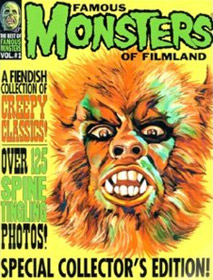
Well-known fan Forrest J. Ackerman launches a trial issue of Famous Monsters of Filmland magazine, featuring no fiction but a generous sampling of sensational movie stills. It sells over 300,000 copies and becomes a regular periodical later in the year, helping to define the cult of monster-movie fandom while hardly promoting the notion of science fiction as adult literature.
January 31
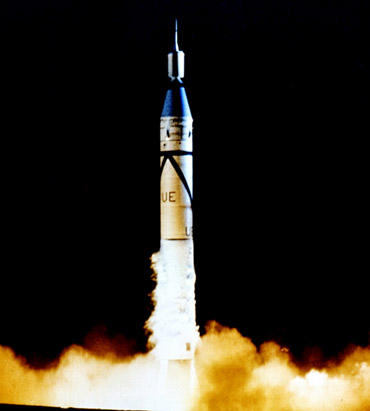
The first successful American satellite, Explorer I, is launched into orbit.
February 21
Gerald Holtom reveals his design of a peace symbol, which will be widely iconic in coming decades, on behalf of Britain’s Campaign for Nuclear Disarmament, which will be formally launched by Bertrand Russell on February 25.
March
James Blish’s A Case of Conscience is published.
March–April
Fritz Leiber’s The Big Time is serialized in Galaxy Science Fiction, and will win Leiber his first Hugo Award.
March 22
C. M. Kornbluth dies of a heart attack in Levittown, N.Y.
March 27
Nikita Khruschev becomes premier of the Soviet Union.
April
The recession of 1958, the most significant economic downturn since the end of World War II, reaches its nadir; unemployment in Detroit reaches 20 percent.
June
Algis Budrys’s Who? Is published by Pyramid Books.
July 7
President Eisenhower signs the Alaska Statehood Act, admitting Alaska to the union.
July 19
The British rock group The Quarrymen, later to be known as the Beatles, record their first demonstration disk in Liverpool.
July 29
Congress passes legislation creating the National Aeronautics and Space Administration, known as NASA.
August 29
The Fly, with a screenplay by James Clavell based on George Langelaan’s 1957 Playboy story, is released; spawning two sequels and a 1986 remake by David Cronenberg.
August 29–September 1
The 16th annual World Science Fiction Convention is held in South Gate, California, drawing over 320 attendees. Fritz Leiber wins the best novel award for The Big Time, and The Incredible Shrinking Man, with a screenplay by Richard Matheson based on his novel, wins “outstanding movie.”
September 12
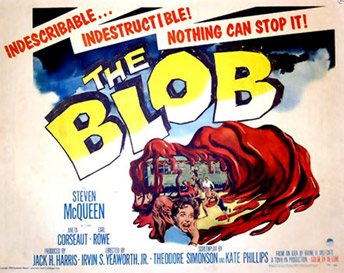
The Blob, a low-budget teen film starring Steve McQueen which develops a cult following and is remade in 1988, is released.
October 11
The Pioneer I unmanned space probe is the first spacecraft launched under the aegis of NASA.
December 9
The far right-wing John Birch Society is created by retired businessman Robert Welch.
December 15
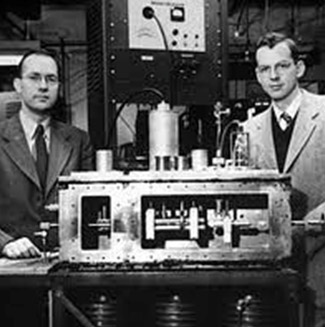
Bell Laboratories scientists Arthur L. Schawlow and Charles H. Townes describe the optical laser in a paper in Physical Review Letters.
January 4
The Soviet Luna 1 satellite becomes the first man-made object to pass the moon and enter a solar orbit.
January 25
American Airlines introduces transcontinental jet passenger service, using the Boeing 707, in a flight from New York to Los Angeles.
February 5
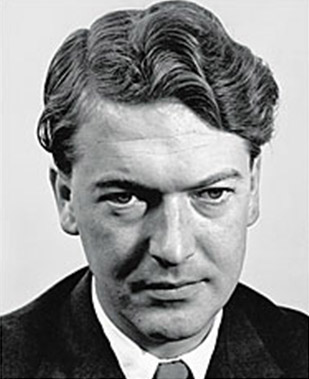
British novelist Kingsley Amis delivers the first of a series of lectures on science fiction at the Christian Gauss Seminars at Princeton. Published in 1960 as New Maps of Hell, it will be instrumental in gaining general literary attention to the genre, and will be the first work of science fiction criticism to be published in a mass-market paperback (by Ballantine).
February 6
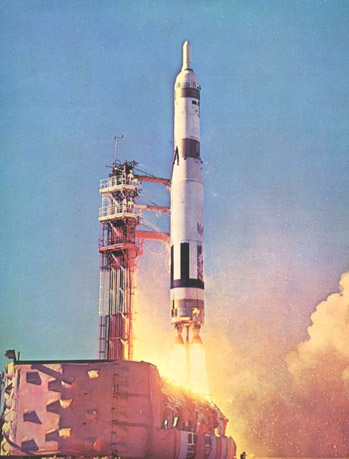
The Titan intercontinental ballistic missile, which will later play a significant role in space exploration, has its first successful firing test at Cape Canaveral, Florida.
February 16
Fidel Castro assumes the premiership of Cuba following a two-year revolution, bringing the Cold War closer than ever to American shores.
March 9
The Barbie Doll is introduced at a New York toy fair.
April
Daniel Keyes’s short story “Flowers for Algernon” is published in The Magazine of Fantasy and Science Fiction, later winning the 1960 Hugo Award. It is expanded into a novel by Keyes in 1966, and is the basis of a 1961 television drama and a 1968 film, both starring Cliff Robertson, who won an Academy Award for the latter.
April 9
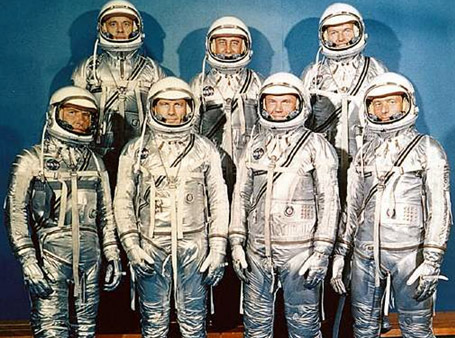
NASA announces the first seven astronauts chosen for its Mercury manned orbital flight program, popularly dubbed the “Mercury 7.”
May 7
British scientist/novelist C. P. Snow delivers the Rede Lecture at Cambridge, later published as The Two Cultures and the Scientific Revolution, instituting a years-long discussion about what he regards as the growing schism between scientific and literary cultures.
July 17
Mary Leakey and her husband, Louis, discover fossil evidence of 1.75-million-year-old Australopithecus hominid in Tanganyika’s Olduvai Gorge.
August 14
The Explorer 8 satellite transmits the first picture of Earth from space.
September
The Magazine of Fantasy and Science Fiction publishes “Nor Custom Stale,” the first science fiction story by Joanna Russ, who will become one of the leading feminist science fiction writers and critics of the next two decades.
September 4–7
The 17th annual World Science Fiction convention is held in Detroit, with an attendance of 371. James Blish wins the best novel Hugo for A Case of Conscience.
September 12
Texas Instruments engineer Jack Kilby invents the microchip, a silicon wafer that functions as a transistor, opening the way to increasing miniaturization and efficiency of computers.
September 30
TV series Men Into Space debuts on CBS, attempting to portray with documentary realism near-future space exploration in the context of the Cold War. With occasional scripts by science fiction writers like Jerome Bixby and David Duncan, it lasts less than a year.
October
Walter M. Miller, Jr.’s A Canticle for Leibowitz, expanded from three stories the author had earlier published in The Magazine of Fantasy and Science Fiction, is published by Lippincott. The author’s only novel, it will receive the 1961 Hugo and become one of the genre’s best-known titles.
October 2
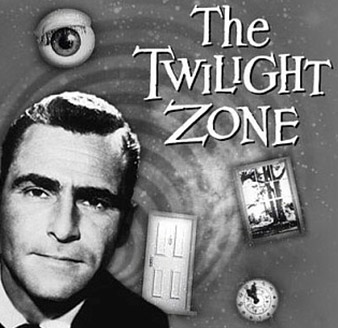
The Twilight Zone debuts on CBS with Rod Serling as host and chief writer; it will feature scripts and adaptations by Richard Matheson, Ray Bradbury, and others, and become among the most influential of science fiction/fantasy TV series.
October 7
Soviet Luna spacecraft transmits first photos from the far side of the moon.
December
Robert A. Heinlein’s Starship Troopers, an abridged form of which was serialized in The Magazine of Fantasy and Science Fiction during the previous two months, is published, becoming his most controversial novel so far in terms of its political stance and adult themes.
December
A decade that began with twenty-five separate American science fiction magazines on the market ends with only six surviving magazines.




